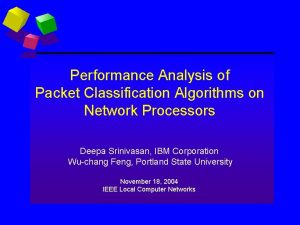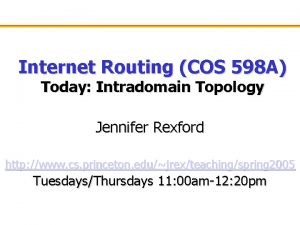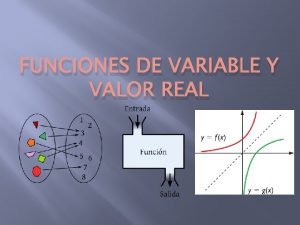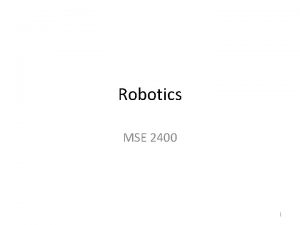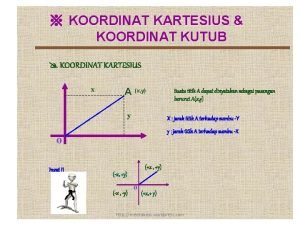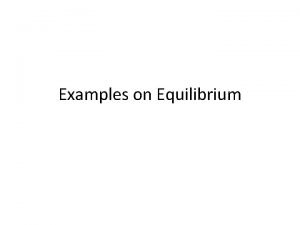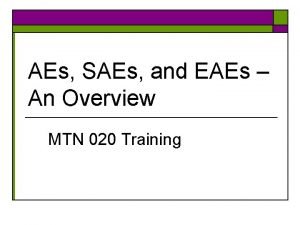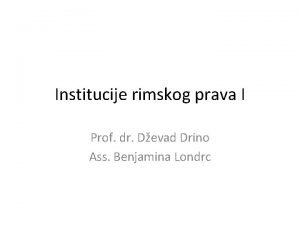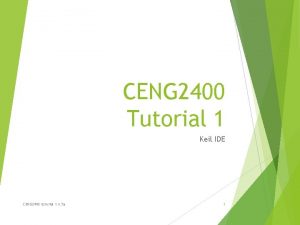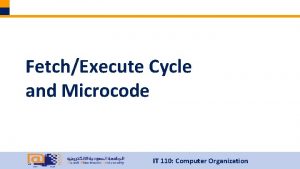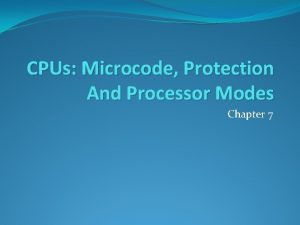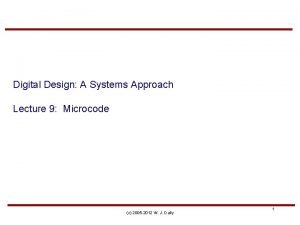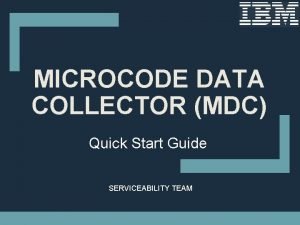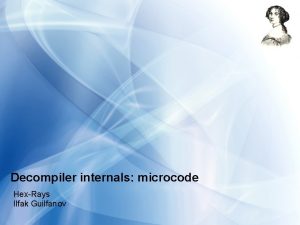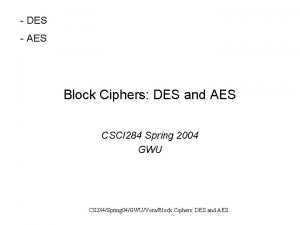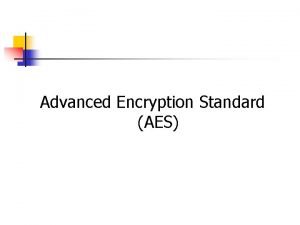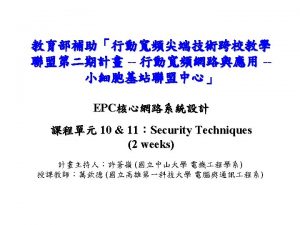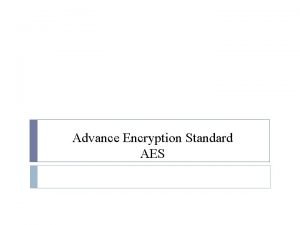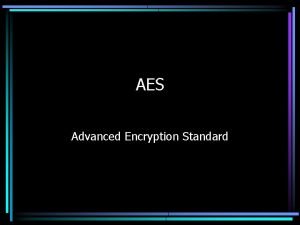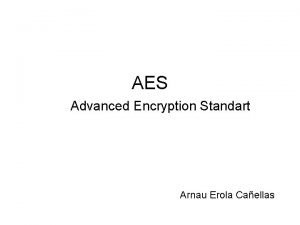AES Microcode Implementation In IXP 2400 And A









![Microcode Overview n n n n n alu [ dest 1, a, +, b] Microcode Overview n n n n n alu [ dest 1, a, +, b]](https://slidetodoc.com/presentation_image/557811e83c63b39ebf9f50c042a81bcd/image-10.jpg)











![Some of The Crypto Commands n n crypto_write_ram($$orig_plain_text[0], DATA_RAM_ADDR, 8, ENCRYPT _UNIT, ram_sig) Perform Some of The Crypto Commands n n crypto_write_ram($$orig_plain_text[0], DATA_RAM_ADDR, 8, ENCRYPT _UNIT, ram_sig) Perform](https://slidetodoc.com/presentation_image/557811e83c63b39ebf9f50c042a81bcd/image-22.jpg)


- Slides: 24

AES Microcode Implementation In IXP 2400 And A study of Reconfigurable Crypto Unit Piyush Ranjan Satapathy CS 203 B Class Project Presentation

Road Map n AES Algorithm Overview IXP 2400 Platform: A Quick Look Microcode: Overview Implementation of AES Experimental Results n Reconfigurable Crypto unit of Intel IXP 2850 n n

Algorithm Overview n n n n n Designed by Daemen and Rijmen for the NIST Originally called Rijndael Symmetric key block substitution cipher Replacement for DES Successful field testing sinception Three bit-modes State defined as a 4 x 4 array of 16 bytes Key size is either 16, 24, or 32 bytes A byte is represented by Galois polynomials Bit Mode Key Length (Nk words) State Numbe Size r (Nb of words) Rounds (Nr) 128 4 4 10 192 6 4 12 256 8 4 14

Kn Stages of AES Algorithm: Result from round n-1 Pass to round n+1 Byte. Sub Shift Row Mix. Column Add. Round. Key Detailed view of round n u Each round performs the following operations: u Non-linear Layer: No linear relationship between the input and output of a round u Linear Mixing Layer: Guarantees high diffusion over multiple rounds u Very small correlation between bytes of the round input and the bytes of the output u Key Addition Layer: Bytes of the input are simply EXOR’ed

1. Sub. Bytes Function n Affine Transformation in GF (28) Direct implementation is complex Easily performed by a 16 x 16 LUT ROM n Simple byte substitution n Combinational logic Each byte at the input of a round undergoes a non-linear byte substitution according to the following transform Substitution (“S”)-box

2. Shift Row Depending on the block length, each “row” of the block is cyclically shifted according to the above table n n n Shifting done only on the bottom three rows of the State Left rotate for encryption Right rotate for decryption

3. Mix. Columns Function Each column is multiplied by a fixed polynomial C(x) = ’ 03’*X 3 + ’ 01’*X 2 + ’ 01’*X + ’ 02’ • • • Matrix multiplication in GF (28) This corresponds to matrix multiplication b(x) = c(x) a(x): Mix. Columns functionality resides primarily in the controller and instruction memory A series of conditional XOR and left shift operations

4. Key Expansion and Addition n n Performed before both the encrypt and decrypt process Byte values from the Key are read and manipulated into the Round. Key A series of Sub. Bytes and XOR operations with RCON ROM values and the Key Performs XOR operation between the State and the Roundkey This is the only function without an inverse Each word is simply EXOR’ed with the expanded round key

IXP 2400 Platform: A Quick Look Name Size. Bytes Transfer Size(Bytes) Reference latency in cycles GPR/ME 256*4 4 1 TR/ME 512*4 4 1 NNR/ME 128*4 4 1 LM/ME 640*4 4 3 Scratch 16 K 4 60 SRAM 64 M 4 90 DRAM 1 G 16 120 • achieve high processing performance • programming flexibility • Cheaper than ASIC
![Microcode Overview n n n n n alu dest 1 a b Microcode Overview n n n n n alu [ dest 1, a, +, b]](https://slidetodoc.com/presentation_image/557811e83c63b39ebf9f50c042a81bcd/image-10.jpg)
Microcode Overview n n n n n alu [ dest 1, a, +, b] ALU addition of a and b and storing in dest 1 alu [ dest 2, dest 1, -, c] ALU subtraction Move(reg 1, reg 2) Moving from one reg 1 to reg 2 ; both are gprs. Immed[reg, ox 0020] Immediate value assignment to register local_csr_wr[ACTIVE_LM_ADDR_0, 0 x 0] Local memory indexing with index 0. begin … endm Macro begin and end. if …. endif If loop xbuf_alloc ($$state, 4, read) buffer allocation in DRAM transfer register. reg gen_regiater $sram_reg $$dram_reg Register declaration. sig sram_sig dram_sig signal declaration. while …. endw While looping #for round[1, 2, 3, 4, 5, 6, 7, 8, 9, 10] … #endloop For looping alu_shf[index, --, B, s 0, >>24] Alu shift function of B scratch[read, $T, index, 0, 1], ctx_swap[sram_sig] scratch read instruction ld_field_w_clr[t 1, 1000, $T] Performs a write to t 1 register dram[write, $$out[0], dst_addr, 0, 2], sig_done[dram_sig] Dram write ctx_arb[dram_sig], ctx_arb[kill] signaling

Implementation Setup n n n n Environmental Setup: Intel IXP 4. 1 600 MHz ME configurations 200 -MHz SRAMs 150 -MHz RDRAMs Executed in Multi threads Executed in Different Micro Engines

Experimental Results(1) SRAM Utilization ME utilization %

Experimental Results(2) Throughput Performance Across Threads in 1 ME

Crypto Unit of IXP 2850

Intel IXP 2850 Encryption Data Flow

Crypto Unit Overview

Simple Encrypt Example

Simple Encrypt and Hash Example

3 DES Core �� 2 Cores per crypto unit n �� Takes 192 -bit key n –(56 -bit + 8 -bit parity) x 3 Keys n �� Operates on 8 -byte blocks n �� Result is written to ME transfer registers or TBUF element n �� Result can be passed to the SHA-1 unit for hashing Security Processing, pipelining, and interleaving using three wires and one core Multiple keys and IVs

AES Core n �� All AES key sizes are supported n n n –(128, 192, or 256) Both Encryption and Decryption supported �� Operates on 16 byte blocks AES Key Scheduler

SHA 1 Core n n n 2 SHA-1 cores per crypto unit Operates on 64 -byte blocks Data is loaded from Input RAM or Crypto cores into the SHA-1 buffer Can perform on unmodified packet data or on the ciphered packet data Operates on 512 bit block size and has a data buffer to accumulate the ciphered data This gives flexibility to run SHA and AES, 3 DES at different rates. SHA 1 Critical Path Analysis
![Some of The Crypto Commands n n cryptowriteramorigplaintext0 DATARAMADDR 8 ENCRYPT UNIT ramsig Perform Some of The Crypto Commands n n crypto_write_ram($$orig_plain_text[0], DATA_RAM_ADDR, 8, ENCRYPT _UNIT, ram_sig) Perform](https://slidetodoc.com/presentation_image/557811e83c63b39ebf9f50c042a81bcd/image-22.jpg)
Some of The Crypto Commands n n crypto_write_ram($$orig_plain_text[0], DATA_RAM_ADDR, 8, ENCRYPT _UNIT, ram_sig) Perform and wait for the write crypto_load_iv($$iv[0], 1, ENCRYPT_UNIT, CRYPTO_BANK, ENCRYPT_STATE, iv_sig) Loading IV Data crypto_load_key($$key[0], 3, ENCRYPT_UNIT, CRYPTO_BANK, ENCRY PT_STATE, key_sig) Loading Key crypto_cipher($$encrypt_data[0], DATA_RAM_ADDR, 8, CRYPTO_CIPHER _ENCRYPT, CRYPTO_CIPHER_NO_CBC, CRYPTO_CIPHER_3 DES, ENCRYPT_UNIT, CRYPTO_BANK, ENCRYPT_STATE, cipher_sig)

Acknowledgement n n n Yan Luo Chris Baron http: //cnscenter. future. co. kr/resource/rsccenter/presentation/intel/spring 2003/S 03 US CPTS 92_OS. pdf ( For some slides) Mel Tsai; UC Berkeley (For some slides) Thomas Sodon et al, EE College of New. Jersey Zhangxi Tan et al, Tsinghua University

 Multilateral peering osaka
Multilateral peering osaka Blackhole mac
Blackhole mac Intel ixp
Intel ixp Ixp-598
Ixp-598 Phil has 20 sweets in a bag
Phil has 20 sweets in a bag Fonovision
Fonovision Dominio contextualizado
Dominio contextualizado Mse-2400
Mse-2400 Isre 2400
Isre 2400 Cam is going to roll a fair 6-sided die 2400 times
Cam is going to roll a fair 6-sided die 2400 times 60 ın yüzde 60 ı kaçtır
60 ın yüzde 60 ı kaçtır Resolución 2400 de mayo 22 de 1979
Resolución 2400 de mayo 22 de 1979 Nyatakan koordinat. a
Nyatakan koordinat. a Revisornævnet afgørelser
Revisornævnet afgørelser 0900 zulu time
0900 zulu time Dborah
Dborah Libra a kg
Libra a kg Stromerzeuger baumaterial vito
Stromerzeuger baumaterial vito Cache attacks and countermeasures: the case of aes
Cache attacks and countermeasures: the case of aes Aes and saes
Aes and saes Aes resonator
Aes resonator Concursus causarum
Concursus causarum Vis ac metus
Vis ac metus Gesta per aes et libram
Gesta per aes et libram Gesta per aes et libram
Gesta per aes et libram


